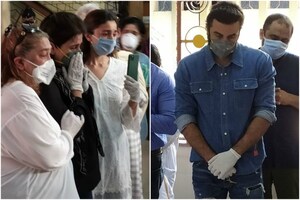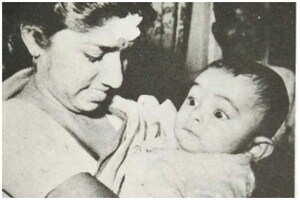While filming the song O Hansini, actor Rishi Kapoor wanted to wear a black bell-bottom trouser that he had picked up during one of his trips abroad. When his dress dada (costume assistant) saw the pant, he informed Kapoor that it was actually a woman's trouser because the zip was on the side, and not in the front. Kapoor was embarrassed by his ignorance, but that stop him from wearing the pant in the film anyway.
That was the thing about Kapoor's fashion sense. It was unapologetic, on several occasions gender-neutral, and appealed to a vast majority of Indian men for its flamboyant, yet casual, grace. One of the reasons why the scion of Bollywood's illustrious Kapoor khandaan was also one of the most popular style icon for Indian men in the 70s, 80s and 90s was because his signature styles -- sweaters, turtle necks and muffler combo, bell-bottoms, and oversized goggles -- were all accessible by men from different section of the society.
His style was never dependent on his physicality. In fact, the actor struggled with his weight, especially in the later part of the 80s, and early 90s when a new crop of actors had come in and were bagging more leading roles. But, like most famous actors of his generation, he never went into a body building spree, and instead depended heavily on his costumes and performances to build his characters onscreen.
Back then, costume designers were not part of most films and therefore, many of the clothes that the actor had worn onscreen over the years are also a testimony of his personal style.
Ushering in the 70s' in Screaming Colors
Kapoor's debut film in a leading role, Bobby (1973) established him as the newest chocolate boy of Bollywood and while his co-star Dimple Kapadia became a fashion icon overnight for her Bobby printed ( polka dot) and knotted cropped tops and mini skirts, Kapoor too established himself as a young trend setter.
The actor ushered in the wild energy of the 70s in screaming colors. Until then, Bollywood men had stuck to the stereotype of gender based dressing (except for a few wonderful mavericks like Dev Anand and Shammi Kapoor), and chose to wear simple masculine colors, and muted tones. But, Kapoor started out differently. He wasn't afraid to wear pink corduroy pants with red shirt in Hum Tum Ek Kamre Mein Band Ho, and didn't shy away from wearing matching suits in deep red velvet and navy blues in the film.
He went all out with his love for oval oversized goggles in the film, and even embraced his feminine side by wearing baby blue pastel and geometric printed shirts.
Until Bobby, Bollywood had never witnessed a young romance onscreen. Most famous actors debuted well into their twenties, but Kapoor and Kapadia brought a new vigour and vibe into the era. Kapoor instantly became a teen heartthrob. He became the boyfriend every young girl wanted and the guy every young boy desired to be. But, Kapoor's initial style statement was so full of pizzazz that he was aspirational at best, much like his uncle Shammi Kapoor, but not quite relatable. It was only in the later part of his career that he became a regular influencer of style and fashion in middle class households when he moved to more conservative choices like printed pullovers.
But Bobby wasn't about being relatable. In one of the iconic scenes of the film, we see the actor don a tight fitted leather jacket, and pants, with nothing under the jacket but a red scarf. There is no subtleness in it, but it's beauty was in the youthful arrogance with which Kapoor made that outrageous and difficult outfit work. So many of his early fashion choices were equally outrageous until he found himself in Yash Chopra's chic, romantic, warm filtered world and comfortably settled into the role of college jock.
From the Quintessential College Stud to Disco Ball
Three years after Bobby, and a string of hits and misses, Kapoor was cast alongside already established actors like Amitabh Bachchan, and Shashi Kapoor (who was also his uncle in real life) in Yash Chopra's iconic film Kabhie Kabhie (1976).
With this film the audience not only saw that Kapoor could hold up on his own in a cast of talented actors but also loved his casual chic college goer style. One of the things Kapoor popularised in India were casual T-shirts, which was a marked departure from the formal button downs in which the audiences often saw Bollywood leading men until then. It was a trend that public was quick to pick up on and round neck, long sleeved t-shirt became a go to of many college goers during this time.
He wore classics like black overcoats, and leather jackets but also did not completely give up his love for turtle necks and sweater vests in this film. In fact, in Khel Khel Mein (1975), which released a year before Kabhi Kabhie, Kapoor packed preppy elegance of navy blazer and grey pants with the playfulness of a beret with a pom.
The actor never stopped experimenting with his looks onscreen and never shyed away from wearing bling either. In Karz (1980), we also saw Rishi Kapoor in a shiny disco ball resembling shirt and white pant, as he circled around the stage to the tunes of Om Shanti Om.
However, his most popular and iconic style statement came with the end of 80s when he almost patented colorful sweaters and the public loved and emulated them immediately.
Master of Reinventing Style
Kapoor never believed in following fashion. He also had a natural penchant for reinventing himself, not just as an actor but also as a style icon. With the advent of the 90s as then young actors like Shah Rukh Khan, and Amir Khan wore jeans and casual tees, Kapoor chose to do the opposite and opted for cardigans in warm colours, with slim fitted pants, and chunky metallic watches. It obviously took another Yash Chopra movie to discover this style, and this time it was Chandni (1989). While his co-star, Sridevi, was a vision in white and pastel chiffon saris, Kapoor screamed 'Mehbooba' in solid crew neck sweater, and sang 'Tu Mujhe Suna, Main Tujhe Sunau apni prem kahani' with Vinod Khanna in baggy cardigans, wearing gold plated watch.
After Chandni, it became his signature style for many more films to come. In fact, in scenes were he couldn't wear a cardigan, he would just tie it around his neck. In films like Deewana (1992), Bol Radha Bol (1992), Damini (1993), Prem Granth (1996) we saw Kapoor endorse this style with panache, so much so, that many kids growing up in 90s also imitated him.
However, over the years, as Kapoor started playing older roles his characters metamorphed into different individuals not just based on their appearances, but also on the basis of their mannerisms, and characteristics. He so completely became his characters in films like Mulk (2018), and Kapoor and Sons (2016), that one could never find Rishi Kapoor in him. That was the magic of Kapoor, he could not only dress like whoever he wanted and make it look desirable but also become whoever he wanted onscreen.
















